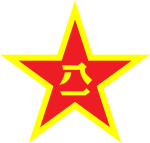The PTZ89 is a late Cold War era tank destroyer of Chinese origin. It was developed in the early 1980's to provide the Chinese military with a potent anti-tank weapon with a better performance than the cannon that were in service at the moment. Most of the tanks in Chinese service at that moment which were armed with a 100mm cannon. The 120mm smoothbore cannon used in the PTZ89 was to become the main armament of future tanks until a 125mm 2A46 derivative was chosen instead.
Armament
The main armament is a 120mm 50-caliber smoothbore cannon which provides a much better penetration than any cannon in Chinese service at that moment. The gun is connected to a semi-automatic loader which gives a rate of fire of 10 rounds per minute. The effective range against tanks ik 2.5 km, but high explosive shells can be fired out to 9 km in an indirect trajectory. Even though a laser range finder is installed the fire control is considered of low quality. A 12.7mm QJC88 heavy machine gun is mounted on the turret roof for self-defense.
Development
Armed with a 120 millimeter smoothbore gun, it was intended to combat newer generations of Western and Russian main battle tanks that were equipped with composite armor and 120 and 125 millimeter caliber guns. Despite a successful development process, with the end of the Cold War it became apparent that the weapon was no longer needed.[3] Production was halted in 1995 after around 100 examples had been built.[3] An official retirement ceremony was held by the 39th Army Group on 3 November 2015.[4][5]
Operators
 China
China
 People's Liberation Army Ground Force: 230 built and in store (no longer in active service)[6]
People's Liberation Army Ground Force: 230 built and in store (no longer in active service)[6]
See also
References
- ^ a b c d e 89式120毫米自走反戰車砲
- ^ PTZ89
- ^ a b "Type 89 Tank Destroyer". China Defence Today sinodefence. Archived from the original on 30 January 2009.
- ^ China to Retire Its Armored Tank Destroyers - Thediplomat.com, 19 November 2015
- ^ "老伙计再见:解放军89式自行反坦克炮开始退役". slide.mil.news.sina.com.cn. Retrieved 11 November 2015.
- ^ The Military Balance 2021. The International Institute for Strategic Studies. 2021. pp. 250–251.



Recent Comments